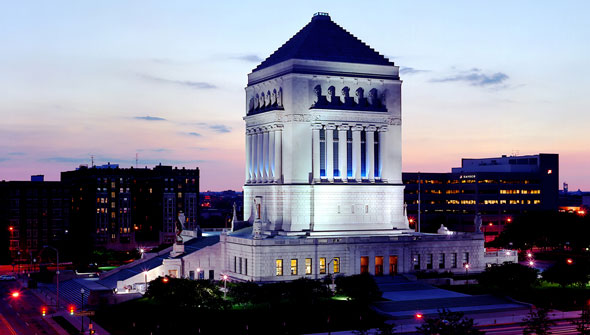Indiana World War Memorial & Museum
50 E. Michigan St.

The architects for this memorial and museum were Walker and Weeks out of Cleveland, OH. The memorial honors the Indiana men killed in World War I. The Military Museum inside also lists all of the Hoosiers killed or missing in action through the Vietnam War. Construction began in 1926, but was not completed until 1965 due to construction delays. The cornerstone was set by General John J. “Black Jack” Pershing who was the American Commander in Europe during WWI. He died in 1948, and never saw the memorial complete.
The memorial was modeled after the Mausoleum of Halicarnassus, one of the Seven Wonders of the Ancient World. The memorial building is set far above street level, and ascends almost 210 feet. Its design mimics the vertical mass of a shrine, with six columns on each side. On the south side of the building sits the largest bronze casting sculpture ever made in America. This sculpture, entitled “Pro Patria”, which means “For the Fatherland” in Latin, was built by Henry Hering and set in place in 1929.
While the exterior of the building is imposing, the interior is likewise impressive. If you arrive during open hours, a tour of the interior is a must as this is one of the city’s greatest interior spaces. Bronze doors on the north side welcome visitors into the stunning art deco lobby. On the top level of the museum, accessed via staircase from the lobby, is the Shrine Room. This room has 20 massive blue stained-glass windows and materials brought in from all the allied nations of World War I. This was done intentionally to symbolize the peace, unity, and world-effort during that war.
The interior also houses a free museum, containing artifacts telling the story of Indiana’s military contributions, from the Revolutionary period to the modern day.
The Indiana World War Memorial is a National Historic Landmark, the highest designation of historic site recognized by the federal government.
